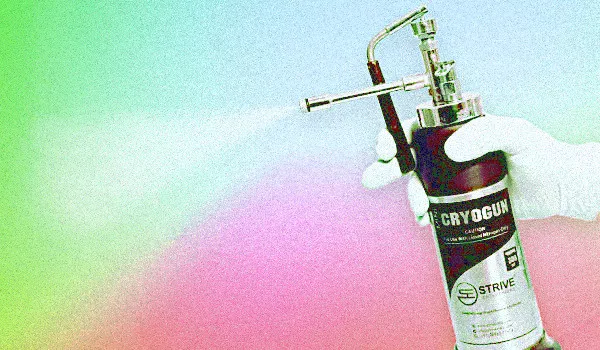
Cryotherapy for Warts in Thailand (Bangkok, Pattaya, Chiang Mai, Phuket, Ko Samui), Malaysia (Penang, Kuala Lumpur), Singapore
HPV and Genital Warts: Risks and Prevention in Gay Men
Human papillomavirus (HPV) is a common sexually transmitted infection (STI) that affects both men and women. While most people with HPV don’t show symptoms, certain strains of the virus can cause genital warts. These warts are not only a cosmetic concern but can also be a sign of increased risk for other health issues, such as certain types of cancer. This is especially relevant for gay men, as they may face a higher risk of HPV-related health problems due to sexual behavior and specific HPV strains that are more easily transmitted through genital contact.
Risks of HPV and Genital Warts in Gay Men
- Increased Risk of Exposure: HPV is transmitted through skin-to-skin contact, which includes sexual contact. Gay men, particularly those who have multiple sexual partners, are at an increased risk of exposure to HPV, including strains that cause genital warts.
- Higher Risk of HPV-related Cancers: Certain strains of HPV can cause cancers, including anal, penile, and throat cancers. Gay men, especially those who engage in receptive anal sex, are at a higher risk of developing anal cancer due to the types of HPV most commonly associated with this behavior.
- Undiagnosed and Asymptomatic Cases: Many individuals with HPV may not show visible symptoms like warts. As a result, someone could unknowingly transmit the virus to others. Regular screenings for anal cancer (especially for those living with HIV) can help detect any issues early.
Prevention of HPV and Genital Warts in Gay Men
- HPV Vaccination: The HPV vaccine, which is effective against the most common strains of the virus, is highly recommended for individuals under the age of 26, and in some cases, even for older individuals (up to age 45). Vaccination can help prevent HPV infection and reduce the risk of developing genital warts and related cancers.
- Condom Use: Using condoms during sexual activity significantly reduces the transmission of HPV, though it doesn’t eliminate the risk entirely. Since HPV can infect areas not covered by a condom, it’s still possible to contract the virus even when using protection, but condoms do reduce the risk.
- Regular Screenings: For men who have sex with men, particularly those living with HIV, regular screenings for anal cancer are important. This can help identify any precancerous changes early, improving the chances of successful treatment.
- Limiting Sexual Partners: Reducing the number of sexual partners and avoiding high-risk sexual behaviors (such as unprotected sex or sharing sex toys) can lower the chances of HPV transmission.
- Cryotherapy for Genital Warts: If genital warts do develop, treatments like cryotherapy (freezing the warts off) can help remove them. It's essential to consult a healthcare provider for the right treatment options and to discuss ongoing prevention strategies.
Types of warts include
- Common warts – Typically found on the hands and fingers.
- Plantar warts – Found on the soles of the feet.
- Flat warts – Smaller and smoother, often appearing in clusters on the face or legs.
- Genital warts – Found in the genital area and usually transmitted through sexual contact.
What is Cryotherapy?
Cryotherapy is a quick and effective treatment that uses extreme cold to freeze and remove warts and other skin issues. Safe, simple, and fast – get back to smooth skin in no time!
At PULSE Clinics, we offer cryotherapy for
- Removal of actinic keratosis
- Removal of seborrheic keratosis
- Removal of skin tags
- Removal of common warts on the hands, arms, body, and feet
- Removal of genital, anal, penile, and vulvar warts
- Removal of molluscum contagiosum
- Removal of dermatofibromas
How Does Cryotherapy Work?
Say goodbye to warts with cryotherapy! Using liquid nitrogen, we freeze and destroy the wart tissue, allowing it to fall off naturally as it heals. Fast, effective, and non-surgical—see results in just a few minutes. Multiple sessions may be needed for full removal. Get smooth, clear skin today!
Benefits and Side Effects of Cryotherapy
Cryotherapy is generally safe and effective, but it’s important to follow your doctor’s advice to minimize side effects and achieve the best results.
Benefits of Cryotherapy
- Fast and Effective: Quickly targets and removes warts and other skin lesions without surgery.
- Minimal Discomfort: Most patients experience only mild discomfort, with no anesthesia required.
- Non-invasive: No cuts or stitches involved, making it a safer option.
- Minimal Downtime: Recovery is quick, with most people returning to normal activities shortly after.
- Precise: Liquid nitrogen targets specific areas for effective treatment.
Side Effects of Cryotherapy
- Pain or Discomfort: You may feel a stinging or burning sensation during and after treatment.
- Blistering: The treated area may form blisters during healing.
- Scarring: Rarely, cryotherapy can cause scarring, especially for larger warts.
- Skin Color Changes: Temporary lightening or darkening of skin may occur.
- Infection Risk: A small risk of infection exists if the treated area isn’t properly cared for.
How to Prepare for Cryotherapy
Before undergoing cryotherapy, follow these simple steps
- Clean the Area: Wash with soap and water to remove dirt and oils.
- Avoid Scratching or Picking: Refrain from scratching or picking at the wart to prevent spreading the virus.
- Inform Your Doctor: Let your doctor know about any allergies, medications, or skin conditions.
- Wear Comfortable Clothing: Choose loose clothing for easy access to the treatment area.
- Avoid Sun Exposure: Minimize sun exposure leading up to your treatment to reduce sensitivity.
Frequently Asked Questions About Cryotherapy for Warts
1. Is it painful?
You might feel mild stinging or burning, but it’s brief and usually not uncomfortable.
2. How many sessions are needed?
Most people need one or two sessions, but larger warts may require more treatments.
3. When will I see results?
The wart will usually start to fall off within 1-2 weeks.
4. Are there side effects?
Blistering or redness is normal and usually goes away on its own.
5. Can it treat genital warts?
Yes, cryotherapy can treat genital warts when done by a trained professional.
6. How should I prepare?
Simply clean the area and avoid touching the wart before your treatment.
7. How long does recovery take?
Most people heal in 1-2 weeks, though it can vary based on wart size and location.
8. Is it safe?
Yes, cryotherapy is safe when done by a qualified professional.
9. How and where can I get it as a foreigner in Thailand, Malaysia, Singapore?
As a foreigner, you can easily access cryotherapy for warts at several reputable clinics in Thailand, Malaysia, Singapore. Look for highly-rated dermatology or aesthetic clinics, or ask for recommendations from local hotels or expat communities.
10. How to book and what to expect?
- Online Booking: Many clinics offer online appointment booking.
- Call Ahead: It’s always a good idea to confirm cryotherapy availability.
- Documents: Bring your passport for identification. Payment is typically required upfront, and many places accept international credit cards.
11. Do PULSE Clinics Thailand, Malaysia, Singapore provide cryotherapy for warts?
Yes, PULSE Clinics Thailand, Malaysia, Singapore offer cryotherapy for warts and other skin conditions. They provide a range of dermatology treatments, including cryotherapy.
HPV and genital warts pose significant risks for gay men, particularly due to increased exposure through sexual contact. Prevention strategies like HPV vaccination, condom use, and regular screenings can greatly reduce these risks. Cryotherapy is an effective treatment for removing genital warts, offering a fast, non-invasive option with minimal downtime. By taking proactive measures, such as vaccination and early detection, the risks of HPV-related complications can be minimized.
 Parnrawee Wadbua
Parnrawee Wadbua


